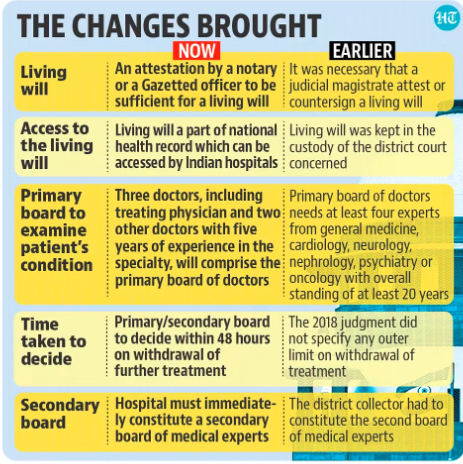Context:
The Supreme Court has ruled that terminally ill patients can now choose to die with dignity. The court has removed the obstacles in implementing advance medical directives for such patients.

Image Source: Hindustan Times
About Advance Medical Directive:
- An advance medical directive (AMD) is a document that allows patients to specify their end-of-life medical treatment preferences.
- According to the Supreme Court order, the AMD needs to be signed by the patient and two independent witnesses in the presence of a notary or gazetted officer.
- Copies of the AMD will be given to close relatives, the family doctor, and a local government official.
Process of Implementation:
- When the patient is terminally ill, the treating doctor will verify the authenticity of the AMD.
- The hospital will then form a primary medical board to verify the patient’s condition within 48 hours.
- If necessary, a secondary medical board will also be formed. If both boards agree to withdraw medical care, the hospital will inform the Judicial Magistrate and follow the AMD.
- If the boards refuse to follow the AMD, the patient or treating doctor can approach the High Court.
No Advance Medical Directive:
- If there is no AMD, the treating doctor can inform the hospital, and a primary medical board will be formed.
- The board will meet with the patient’s family or next of kin and record the discussion in writing.
- The process for implementation will be the same as for patients with an AMD.
Who can execute the advance directive and how?
- The advance medical directive can only be executed by an adult who is of a sound and healthy state of mind and in a position to communicate, relate and comprehend the purpose and consequences of executing the document.
- It must be voluntarily executed and without any coercion or inducement or compulsion and after having full knowledge or information.
- Consent of the individual is necessary and it shall be in writing “stating as to when medical treatment may be withdrawn.
About Active and Passive Euthanasia:
| Active Euthanasia |
Passive Euthanasia |
- The apex court, in the Aruna Shanbaug case, said that active euthanasia “entails the use of lethal substances or forces to kill a person, e.g. a lethal injection”.
- This means that a terminally-ill patient is administered a lethal drug or substance intentionally in order for them to pass away peacefully, in this case, in the event of terminal illness.
|
- Also called negative euthanasia or non-aggressive euthanasia, it was defined by the apex court, as that which “entails withholding of medical treatment for continuance of life, e.g. withholding of antibiotics where without giving it a patient is likely to die”.
- This means that if a patient has been kept alive by the use of life-saving medical equipment, such as a ventilator, or drugs or substances, such as food administered through a pipe or medicines, then these would be stopped and the patient would be allowed to die a ‘natural course of death’.
|
News Source: The Hindu
![]() 4 Feb 2023
4 Feb 2023
